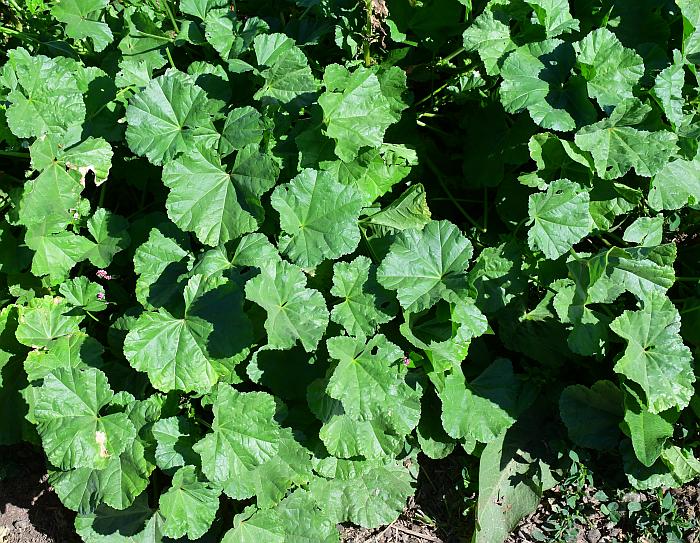Malva pusilla Sm.
Dwarf Mallow

Introduced
CC = *
CW = 5
MOC = 7
© SRTurner
Malva pusilla Sm.Dwarf Mallow | |
 |
Introduced CC = * CW = 5 MOC = 7 |
© SRTurner |
|
Family - Malvaceae Habit - Annual or perennial forb. Stem - Spreading to ascending, to 1 m, sparsely pubescent with simple and stellate hairs.
Leaves - Alternate, simple, long-petiolate, stipulate. Petioles stout. Stipules 3-5 mm long, narrowly triangular to ovate-triangular. Leaf blades 1-5 cm long, flat or slightly crisped along the margins, circular to broadly kidney-shaped in outline, unlobed or broadly and very shallowly 5-lobed (much less than 1/2 way to the base), the margins finely scalloped or toothed, the surfaces glabrous or sparsely pubescent with mostly fasciculate and stellate hairs, especially at the base.
Inflorescences - Dense axillary clusters, the flowers short-to long-stalked at flowering, the stalk elongating as the fruits develop, the bractlets subtending the calyx linear, with simple and fasciculate hairs along the margins.
Flowers - Calyces 3-5 mm long at flowering, initially cup-shaped, not or only slightly enlarged and flattened horizontally at fruiting, at least the lobes remaining green, herbaceous, and without a distinct network of veins, the outer surface pubescent with mostly simple and fasciculate hairs, the marginal hairs 0.6-1.2 mm long (mostly more than 1 mm long). Petals 0.3-0.5 cm long, slightly shorter than to slightly longer than the calyx, white, light pink, or pale lavender. Stamens numerous, the staminal column terete, glabrous or hairy toward the base, the anthers usually white. Pistils with 8-20 locules, the carpels arranged in a flattened ring around a relatively broad central axis. Styles fused most of their length, each branch with a single linear stigmatic area along the inner side toward the tip.
Fruits - Schizocarps separating into 8-20 wedge-shaped mericarps, 1.5-2.0 mm long, the dorsal surface flat, glabrous or finely stellate-hairy, strongly transversely wrinkled, and with a reticulate pattern of thickenings, the junction between the dorsal and lateral surfaces narrowly angled and sometimes appearing toothed (but generally not noticeably winged), the sides thin and papery, with a radiating network of thickened veins. Seeds kidney-shaped to nearly circular, 1.0-1.5 mm long.
Flowering - May - October. Habitat - Open disturbed areas, barnyards. Origin - Native to Europe. Lookalikes - M. parviflora, M. neglecta. Other info. - This species is uncommon in Missouri, known from only a few widely scattered states and collected only once in the last 50 years. In the continental U.S. it is found in scattered areas mostly in the northern half of the country. Its distribution lacks a well-defined pattern. The plant is recognized by its sprawling habit, roundish leaves on long petioles, and clusters of small white flowers. The flowers are smaller than those of the more common lookalike, M. neglecta, which has petals about double the length of the calyx. It is most similar to M. parviflora, but that species has mostly stellate hairs on the calyx. Confident ID of some specimens can be difficult. Photographs taken at the Whiskey Creek Sheep Farm, near Krakow, Franklin County, MO, 6-16-2021 (SRTurner). |